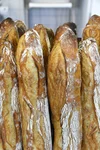Celebrating the baguette with five bite-sized facts

Some love it for its crispy golden crust, others for the fluffiness of its crumbs, but the French all agree that the baguette is their favorite loaf. Indeed it’s so embedded in the French way of life that the French Ministry of Culture is campaigning for the baguette to be on UNESCO’s list of intangible heritage in autumn 2022.
To celebrate this icon of French culture, Google Arts & Culture partnered with specialist institutions, including Meilleurs Ouvriers de France and Confédération des Boulangers, to share what made it the most quintessential of French symbols — and how the savoir-faire is passed down through the generations.
Featuring more than 2000 images and 75+ Stories from historians, French bakers and culinary experts, La Baguette gives a fragrant taste of the French staple. We also built a dedicated game “Baguette Sprint” so everyone can learn in a playful way.

In the meantime, here are five bite-sized facts about the much-loved loaf:
1. Its origins are a mystery
Image courtesy of Fonds de dotation EKIP

To this day the origin of the baguette is a mystery. Was it invented to be easily carried to the battlefields in the pockets of Napoleon's troops? Or was it shaped to be torn by hand – so avoiding knife fights between subway workers? Although its exact origins are still debated, historians agree that the long and thin bread started capturing the hearts of Parisians in the 20th century, before making its way to the world and becoming an iconic symbol of French culture.
2. Six billion baguettes are produced each year
Photo courtesy of Frédéric Vielcanet

Anyone who has visited France won’t be surprised to learn the baguette is an integral part of French daily life. Around 12 million people visit a bakery every day, and six billion baguettes are produced each year in France.
3. There are 35,000 artisanal bakeries in France
Photo courtesy of Thomas Déron

Faced with such high demand, the sector is always in need of a sizable workforce and it can be a challenge to recruit and train young bakers. In 1970, there were 55,000 bakers; today this number has shrunk to 35,000, a drop of 36% in 50 years. And of course bakeries don’t only provide sustenance, they are a vital part of communities in many areas where they are the only local shop.
4. It has only four ingredients
Image courtesy of Rougereau

Made with just flour, water, salt and yeast, the traditional French baguette accompanies every meal. However it’s eaten at any hour of the day and can be found everywhere from the dining table of the President at the Elysée to school kids’ backpacks for their afternoon snack. The flavor of a great baguette remains a constant though, thanks to the expertise of the wheat farmers and millers who provide the major ingredient.
5. The baguette awards
Photo courtesy of Joël Defives

The savoir-faire of baguette craft, and the generations of bakers who perfected it, is celebrated by competitions such as the prestigious “Concours de la Meilleure baguette de tradition française.” Traditionally the winner bakes the baguettes for the Elysée. Every four years, the best bakers enter another competition for the highest recognition in the trade – Meilleur ouvrier de France – and spend years perfecting their skills to compete for this honorific title. Get ready to compete by shaping your own baguette with this guide.






